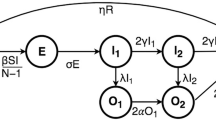Abstract
The spread of COVID-19 between different agents in a hospital emergency department can be simulated by modeling the interactions between the agents and the environment. In this research, we use Agent Based Modeling and Simulation techniques to build a model of COVID-19 propagation based on an Emergency Department Simulator which has been tested and validated previously. The benefits of ABM include its ability to simulate complex systems, its flexibility, and its ability to model the interactions between different agents in the system. The obtained model will allow us to build a propagation simulator that enables us to build virtual environments with the aim of analyzing how the interactions between agents influence the rate of virus transmission. The model can be used to study the effectiveness of different interventions, such as social distancing, wearing masks, and vaccination, in reducing the spread of COVID-19.
Access this chapter
Tax calculation will be finalised at checkout
Purchases are for personal use only
Similar content being viewed by others
References
Davoli, E., World Health Organization: A practical tool for the preparation of a hospital crisis preparedness plan, with special focus on pandemic influenza. WHO Regional Office for Europe, No. EUR/06/5064207, Copenhagen (2006)
Taboada, M., Cabrera, E., Iglesias, M.L., Epelde, F., Luque, E.: An agent-based decision support system for hospitals emergency departments. Procedia Comput. Sci. 4, 1870–1879 (2011)
Cabrera, E., Luque, E., Taboada, M., Epelde, F., Iglesias, M.L.: ABMS optimization for emergency departments. In: Proceedings of the 2012 Winter Simulation Conference (WSC), pp. 1–12. IEEE (2012)
Liu, Z., Rexachs, D., Luque, E., Epelde, F., Cabrera, E.: Simulating the micro-level behavior of emergency department for macro-level features prediction. In: 2015 Winter Simulation Conference (WSC), pp. 171–182. IEEE (2015)
Jaramillo, C., Rexachs, D., Luque, E., Epelde, F., Taboada, M.: Modeling the contact propagation of nosocomial infection in hospital emergency departments. In: The Sixth International Conference on Advances in System Simulation, pp. 84–89. SIMUL (2014)
Wang, Y., Xiong, H., Liu, S., Jung, A., Stone, T., Chukoskie, L.: Simulation agent-based model to demonstrate the transmission of COVID-19 and effectiveness of different public health strategies. Front. Comput. Sci. 82, 1–8 (2021)
Hinch, R., et al.: OpenABM-Covid19—an agent-based model for non-pharmaceutical interventions against COVID-19 including contact tracing. PLoS Comput. Biol. 17(7), e1009146 (2021)
Ponsford, L.R., Weaver, M.A., Potter, M.: Best practices identified in an academic hospital emergency department to reduce transmission of COVID-19. Adv. Emerg. Nurs. J. 43(4), 355 (2021)
Howick, S., McLafferty, D., Anderson, G.H., Pravinkumar, S.J., Van Der Meer, R., Megiddo, I.: Evaluating intervention strategies in controlling coronavirus disease 2019 (COVID-19) spread in care homes: An agent-based model. Infect. Control Hosp. Epidemiol. 42(9), 1060–1070 (2021)
Morawska, L., Milton, D.K.: It is time to address airborne transmission of COVID-19. Clin. Infect. Dis. 71(9), 2311–2313 (2020)
Morawska, L., et al.: How can airborne transmission of COVID-19 indoors be minimised? Environ. Int. 142, 105832 (2020)
Rahaman, H., Barik, D.: Investigation of airborne spread of COVID-19 using a hybrid agent-based model: a case study of the UK. R. Soc. Open Sci. 10(7), 230377 (2023)
Acknowledgments
This research has been supported by the Agencia Estatal de Investigacion (AEI), Spain and the Fondo Europeo de Desarrollo Regional (FEDER) UE, under contract PID2020-112496GB-I00 and partially funded by the Fundacion Escuelas Universitarias Gimbernat (EUG).
Author information
Authors and Affiliations
Corresponding author
Editor information
Editors and Affiliations
Rights and permissions
Copyright information
© 2025 The Author(s), under exclusive license to Springer Nature Switzerland AG
About this paper
Cite this paper
Ansari Dogaheh, M., Taboada, M., Epelde, F., Luque, E., Rexachs, D., Wong, A. (2025). An ABMS COVID-19 Propagation Model for Hospital Emergency Departments. In: Naiouf, M., De Giusti, L., Chichizola, F., Libutti, L. (eds) Cloud Computing, Big Data and Emerging Topics. JCC-BD&ET 2024. Communications in Computer and Information Science, vol 2189. Springer, Cham. https://doi.org/10.1007/978-3-031-70807-7_8
Download citation
DOI: https://doi.org/10.1007/978-3-031-70807-7_8
Published:
Publisher Name: Springer, Cham
Print ISBN: 978-3-031-70806-0
Online ISBN: 978-3-031-70807-7
eBook Packages: Computer ScienceComputer Science (R0)




